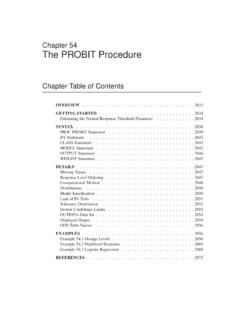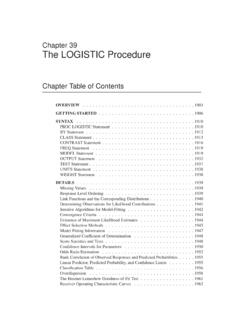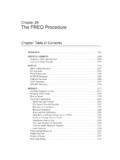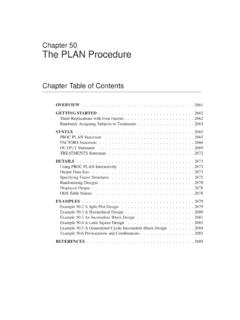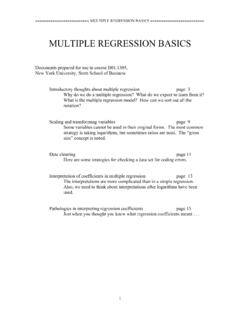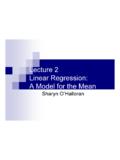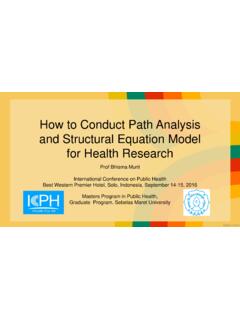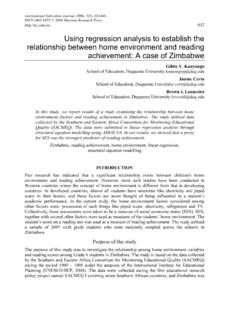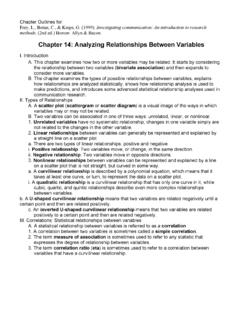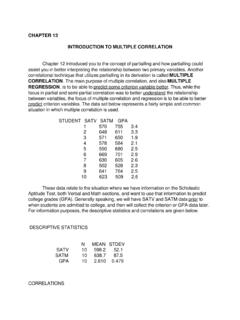Transcription of The PHREG Procedure - Worcester Polytechnic Institute
1 Chapter 49 The PHREG ProcedureChapter Table of Statement ..2581 IDStatement ..2581 MODELS tatement ..2582 OUTPUTS tatement .. Time Distribution ..2593 Partial Likelihood Function for the Cox Process Style of Input ..2595 The Multiplicative Hazards Model .. the Global Null Hypothesis ..2597 Hazards Ratio Estimates and Confidence Linear Hypotheses about regression ..2598 Diagnostics Based on Weighted Residuals .. Distribution Estimates for the Cox Model .. Selection ..2606 ODST ableNames .. Chapter 49. The PHREG ProcedureExample Stepwise regression ..2616 Example Conditional Logistic regression for m:n Matching .. Time-Dependent Repeated ..2640 Example Multiple Failure Outcomes.
2 OnlineDoc : Version 8 Chapter 49 The PHREG ProcedureOverviewThe analysis of survival data requires special techniques because the data are almostalways incomplete, and familiar parametric assumptions may be unjustifiable. Inves-tigators follow subjects until they reach a prespecified endpoint (for example, death).However, subjects sometimes withdraw from a study, or the study is completed be-fore the endpoint is reached. In these cases, the survival times (also known as failuretimes) arecensored; subjects survived to a certain time beyond which their status isunknown. The noncensored survival times are referred to aseventtimes. Methodsfor survival analysis must account for both censored and noncensored are many types of models that have been used for survival data.
3 Two of themore popular types of models are the accelerated failure time model (Kalbfleisch andPrentice 1980) and the Cox proportional hazards model (Cox 1972). Each has itsown assumptions on the underlying distribution of the survival times. Two closelyrelated functions often used to describe the distribution of survival times are the sur-vivor function and the hazard function (see the section Failure Time Distribution on page 2593 for definitions).The accelerated failure time model assumes a parametric form for the effects of theexplanatory variables and usually assumes a parametric form for the underlying sur-vivor function. Cox s proportional hazards model also assumes a parametric formfor the effects of the explanatory variables, but it allows an unspecified form for theunderlying survivor PHREG Procedure performs regression analysis of survival data based on theCox proportional hazards model.
4 Cox s semiparametric model is widely used in theanalysis of survival data to explain the effect of explanatory variables on survival time of each member of a population is assumed to follow its own hazardfunction,hi(t), expressed ashi(t)=h(t;zi)=h0(t)exp(z0i )whereh0(t)is an arbitrary and unspecified baseline hazard function,ziis the vectorof measured explanatory variables for theith individual, and is the vector of un-known regression parameters associated with the explanatory variables. The vector is assumed to be the same for all Chapter 49. The PHREG ProcedureThe survivor function can be expressed asS(t;zi)=[S0(t)]exp(z0i )whereS0(t)=exp( Rt0h0(u)du)is the baseline survivor estimate , Cox (1972, 1975) introduced the partial likelihood function, whicheliminates the unknown baseline hazardh0(t)and accounts for censored partial likelihood of Cox also allows time-dependent explanatory variables.
5 Anexplanatory variable is time-dependent if its value for any given individual can changeover time. Time-dependent variables have many useful applications in survival anal-ysis. You can use a time-dependent variable to model the effect of subjects changingtreatment groups. Or you can include time-dependent variables such as blood pres-sure or blood chemistry measures that vary with time during the course of a can also use time-dependent variables to test the validity of the proportionalhazards alternative way to fit models with time-dependent explanatory variables is touse the counting process style of input. The counting process formulation allowsPROC PHREG to fit a superset of the Cox model, known as the multiplicative haz-ards model.
6 This extension also includes multiple events per subject, time-dependentstrata, and left truncation of failure times. The theory of these models is based onthe counting process pioneered by Andersen and Gill (1982), and the model is oftenreferred to as the Andersen-Gill population under study may consist of a number of subpopulations, each ofwhich has its own baseline hazard function. PROC PHREG performs a stratifiedanalysis to adjust for such subpopulation differences. Under the stratified model, thehazard function for thejth individual in theith stratum is expressed ashij(t)=hi0(t)exp(z0ij )wherehi0(t)is the baseline hazard function for theith stratum, andzijis the vector ofexplanatory variables for thejth individual.
7 The regression coefficients are assumedto be the same for all individuals across all in the failure times may arise when the time scale is genuinely discrete or whensurvival times generated from the continuous-time model are grouped into coarserunits. The PHREG Procedure includes four methods of handling ties. Thediscretelogistic model is available for discrete time-scale data. The other three methods applyto continuous time-scale data. Theexactmethod computes the exact conditionalprobability under the model that the set of observed tied event times occurs before allthe censored times with the same value or before larger provide approximations to the exact selection is a typical exploratory exercise in multiple regression when theinvestigator is interested in identifying important prognostic factors from a largenumber of candidate variables.
8 The PHREG Procedure provides four model selec-tion methods: forward selection, backward elimination, stepwise selection, and bestSAS OnlineDoc : Version 8 Getting Started 2573subset selection. The best subset selection method is based on the likelihood scorestatistic. This method identifies a specified number of best models containing one,two, three variables and so on, up to the single model containing all of the PHREG Procedure also enables you to include an offset variable in the model test linear hypotheses about the regression parameters perform conditional logistic regression analysis for matched case-control stud-ies create a SAS data set containing survivor function estimates, residuals, andregression diagnostics create a SAS data set containing survival distribution estimates and confidenceinterval for the survivor function at each event time for a given realization ofthe explanatory variablesThe remaining sections of this chapter contain information on how to use PROCPHREG, information on the underlying statistical methodology, and some sampleapplications of the Procedure .
9 The Getting Started section on page 2573 introducesPROC PHREG with two examples. The Syntax section on page 2577 describes thesyntax of the Procedure . The Details section on page 2593 summarizes the statis-tical techniques employed in PROC PHREG . The Examples section on page 2608includes eight additional examples of useful applications. Experienced SAS/STAT software users may decide to proceed to the Syntax section, while other users maychoose to read both the Getting Started and Examples sections before proceedingto Syntax and Details. Getting StartedPROC PHREG syntax is similar to that of the other regression procedures in theSAS System. For simple uses, only the PROC PHREG and MODEL statements the following data from Kalbfleisch and Prentice (1980).
10 Two groups ofrats received different pretreatment regimes and then were exposed to a recorded the survival times of the rats from exposure to mortality fromvaginal cancer. Four rats died of other causes, so their survival times are lies in whether the survival curves differ between the two data setRatscontains the variableDays(the survival time in days), the variableStatus(the censoring indicator variable : 0 if censored and 1 if not censored), and thevariableGroup(the pretreatment group indicator).SAS OnlineDoc : Version 82574 Chapter 49. The PHREG Proceduredata Rats;label Days = Days from Exposure to Death ;input Days Status Group @@;datalines;143 1 0 164 1 0 188 1 0 188 1 0190 1 0 192 1 0 206 1 0 209 1 0213 1 0 216 1 0 220 1 0 227 1 0230 1 0 234 1 0 246 1 0 265 1 0304 1 0 216 0 0 244 0 0 142 1 1156 1 1 163 1 1 198 1 1 205 1 1232 1 1 232 1 1 233 1 1 233 1 1233 1 1 233 1 1 239 1 1 240 1 1261 1 1 280 1 1 280 1 1 296 1 1296 1 1 323 1 1 204 0 1 344 0 1;run;In the MODEL statement, the response variable ,Days, is crossed with the censoringvariable,Status, with the value that indicates censoring enclosed in parentheses (0).


